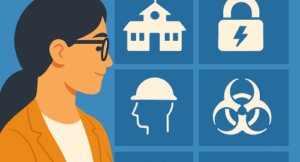Listen to this blog (3 mins)
A safety and security committee enhances the learning environment, improves school culture and climate, and assists with safety efforts. They must know the latest school safety best practices and be ahead of new threats, concerns, and safety mandates. Their end goal is to ensure the safety and well-being of everyone in the district.
Who should be on the committee?
The size of the committee can vary based on district needs and size, but must include at least:
- The school board president and other school board members
- The superintendent
- At least one person the superintendent designates (ideally a classroom teacher)
- A member of the open-enrollment charter school board, if applicable
- At least two parents/guardians of students in the district
- Someone from the district’s county or city emergency management office
- A representative of the local police department or sheriff’s office
- One person from the district’s police department, if applicable
The committee should also collaborate with organizations that can support the committee’s efforts. The school should choose organizations based on their school safety knowledge and experience. These partners may be:
- First responders, law enforcement, EMS, and the fire department
- Local health authorities
- Mental health organizations
- Parent organizations, such as the PTA
- Public works and inspectors
What does the committee do?
The committee meets at least three times each year (once during each academic semester and once over summer). One of their primary objectives is developing, implementing, and continuing to improve the district’s emergency operations plan (EOP). The committee ensures that the district’s EOP reflects the unique needs of each campus and that it is updated as school safety needs and best practices evolve.
They also assist in safety audits and reporting. They review and approve each report for accuracy and provide the findings to the district. The committee should be involved in new construction and/or renovation projects to ensure the plans meet safety needs. They also should collaborate with law enforcement to increase police and school resource officer (SRO) involvement on and near the campus.
Note that some states, like Texas, have laws that mandate the committee’s roles and responsibilities. Make sure to check local laws for specific mandates for your district.
Follow More School Safety Best Practices
To hear more best practices from our nation’s leading K-12 safety experts, check out Raptor webinars and our podcast, School Safety Today. Both feature safety experts and thought leaders on various topics to help schools stay informed on the latest school safety news and recommendations.
To learn more about how the Raptor School Safety Suite can keep your school—and everyone inside of it—safe, contact us today for a personalized demo.





